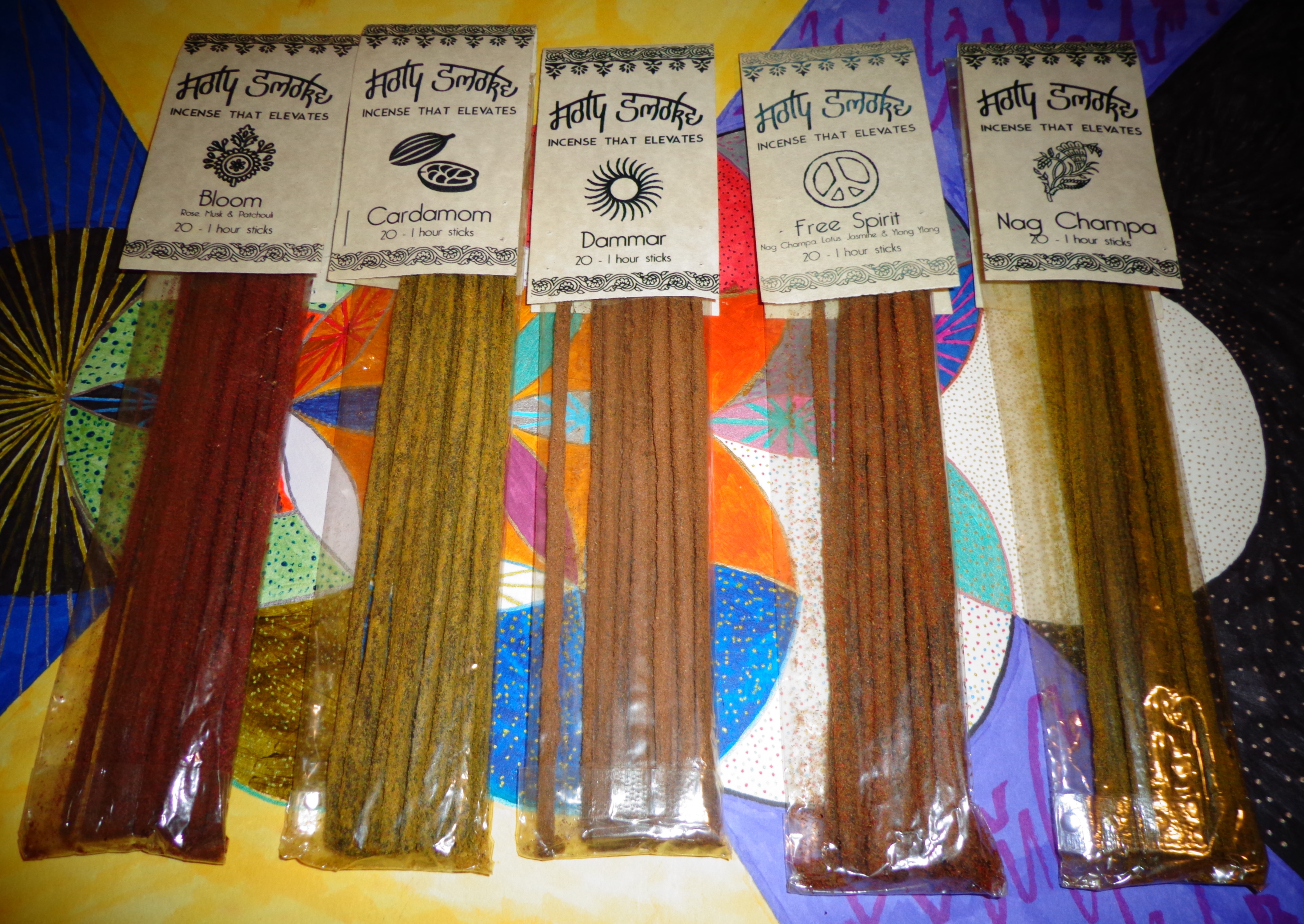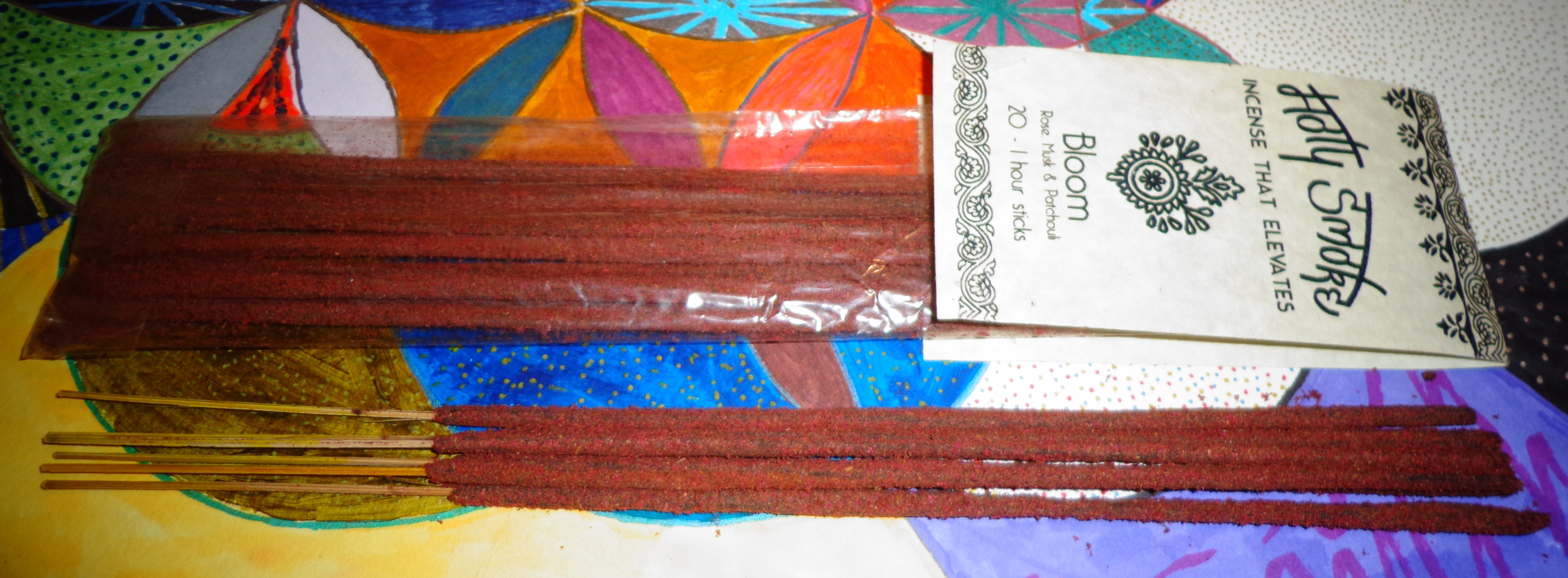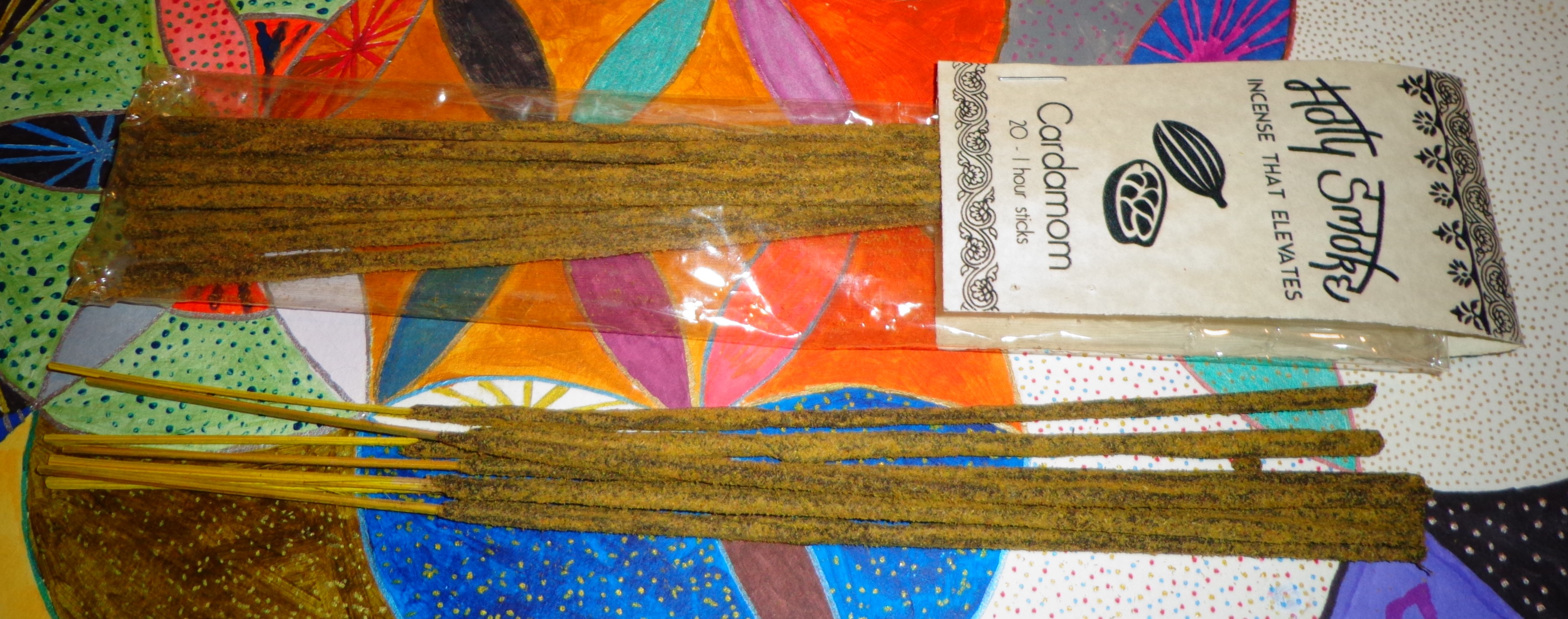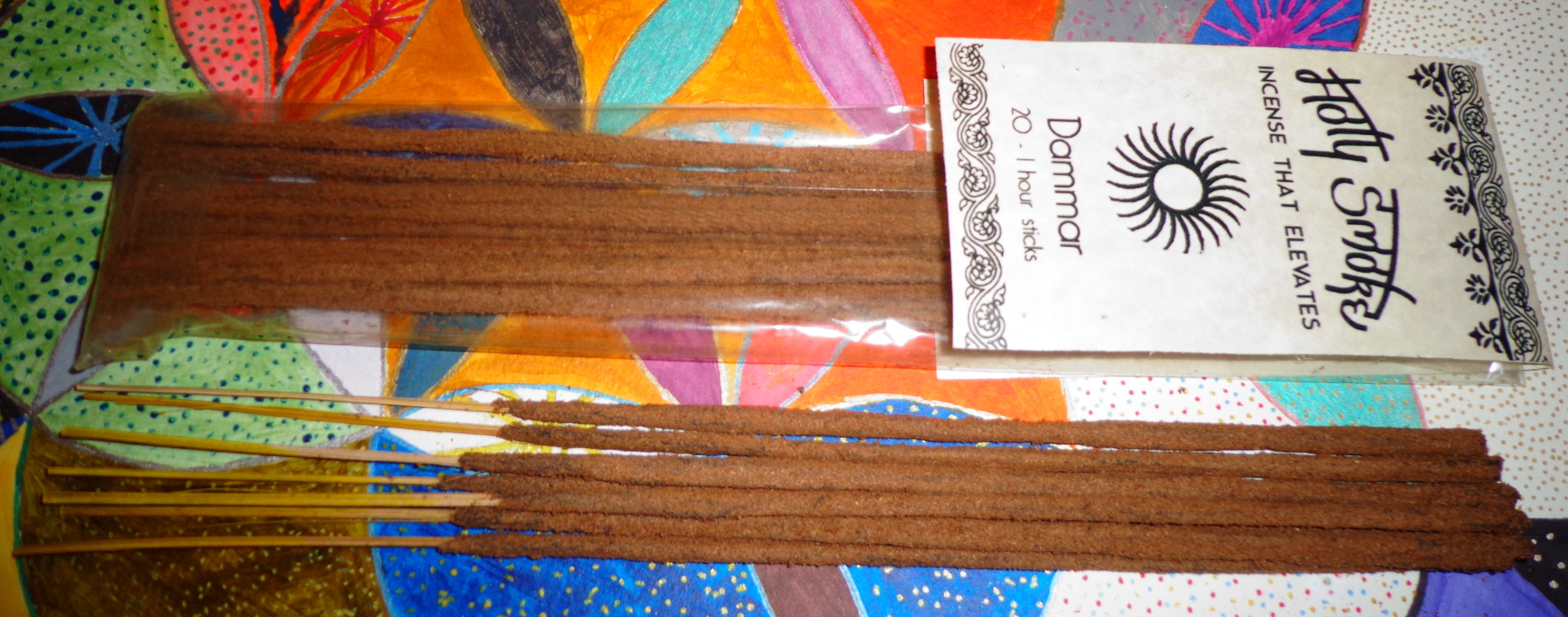 Holy Smoke is the name of a domestic incense creator that can be found on both Etsy and its own website. The company states, “All our ingredients are natural and directly from nature. We try to source the best ingredients to produce the finest products. Our incense sticks are hand-rolled using honey, gum resin, botanicals and pure essential oils. Each stick will burn for an hour or more.” This in particular got my attention because even some of the best Indian incenses (and Holy Smoke sticks are Indian-style for sure) out there can be completely charcoal based which has never really been one of my favorite bases for a scent. And one must admit Holy Smoke present their incenses in a very attractive way at their sales sites. So I was very interested in checking out some of their scents.
Holy Smoke is the name of a domestic incense creator that can be found on both Etsy and its own website. The company states, “All our ingredients are natural and directly from nature. We try to source the best ingredients to produce the finest products. Our incense sticks are hand-rolled using honey, gum resin, botanicals and pure essential oils. Each stick will burn for an hour or more.” This in particular got my attention because even some of the best Indian incenses (and Holy Smoke sticks are Indian-style for sure) out there can be completely charcoal based which has never really been one of my favorite bases for a scent. And one must admit Holy Smoke present their incenses in a very attractive way at their sales sites. So I was very interested in checking out some of their scents.
First of all I was a bit disappointed in that the incenses I received did not have the bright colors that the presentations on line hinted at. This is of course not a deal breaker for a scent, but it IS part of what had me scrambling for a purchase. The incenses do vary a bit in color but one must come to the impression that the lighting may be bringing out what you see a bit more than the reality and in fact if you look at my own pictures in this review, the flash is definitely helping some on that account. In my experience a lot of Indian sticks that use colors may not impart any scent variations through the colors themselves but there is often something psychological about using them and I once raided the Vedic Vaani catalog trying to find the brightly colored ones and this often led to some of their better incenses. So be sure to temper one’s expectations from the pictures.
 So that lovely purple color on the Bloom picture at the Holy Smoke website I don’t really see at all in the actual incense, it turned out to be much redder. This is described as a mix of rose, musk and patchouli, but what you immediately notice is just the overall blast of scent coming from the stick, it’s literally drenched in perfume oils. In fact I did not mind at all letting these sit for a while hoping to temper the power of them a little and even in doing so they still strike me as strong and powerful, perhaps even too much. So it’s probably worth setting one’s expectations that a stick like this at an hour burn and this powerful is likely something you don’t want as close to your space. The other issue, which not all of the sticks have, is that the combination of the oils being used often reminds me of air freshener type scents rather than any of the specific ingredients. As we know getting a legitimate rose oil from an essential is virtually impossible at this price range, but the overall floral scent does seem to be largely drowning out whatever is being used as the musk and patchouli. You can certainly sense both in the mix at some level but the combination still adds up in a way that reminds me if your levels on your CD are too high.
So that lovely purple color on the Bloom picture at the Holy Smoke website I don’t really see at all in the actual incense, it turned out to be much redder. This is described as a mix of rose, musk and patchouli, but what you immediately notice is just the overall blast of scent coming from the stick, it’s literally drenched in perfume oils. In fact I did not mind at all letting these sit for a while hoping to temper the power of them a little and even in doing so they still strike me as strong and powerful, perhaps even too much. So it’s probably worth setting one’s expectations that a stick like this at an hour burn and this powerful is likely something you don’t want as close to your space. The other issue, which not all of the sticks have, is that the combination of the oils being used often reminds me of air freshener type scents rather than any of the specific ingredients. As we know getting a legitimate rose oil from an essential is virtually impossible at this price range, but the overall floral scent does seem to be largely drowning out whatever is being used as the musk and patchouli. You can certainly sense both in the mix at some level but the combination still adds up in a way that reminds me if your levels on your CD are too high.
 The Cardamom is very different to the Bloom. It was actually nice to see this rarely represented spice in an incense and the overall levels turned down a bit. Cardamom is a fairly unique spice but tends to appear as drier in incense which matches a bit better with the honey and resin base. But it does appear that there is more in play than the just the spice (as well as the question of how much of the spice is the actual spice and how much is in the oil). I wondered a bit about some of the natural resin in the midst of it coming through as it seemed somewhat basic quality, perhaps a touch gravelly, but it wasn’t ultimately problematic with the top note. There is some level of a floral feel to this as well as if the base or additional ingredients contribute quite a bit to the overall aroma. It’s an interesting and fairly unique aroma overall, very different to the others I sampled from the catalog. But once again, the sheer strength of the overall stick feels like it gets a bit overwhelming during the burn, something that might be mitigated by burning half sticks.
The Cardamom is very different to the Bloom. It was actually nice to see this rarely represented spice in an incense and the overall levels turned down a bit. Cardamom is a fairly unique spice but tends to appear as drier in incense which matches a bit better with the honey and resin base. But it does appear that there is more in play than the just the spice (as well as the question of how much of the spice is the actual spice and how much is in the oil). I wondered a bit about some of the natural resin in the midst of it coming through as it seemed somewhat basic quality, perhaps a touch gravelly, but it wasn’t ultimately problematic with the top note. There is some level of a floral feel to this as well as if the base or additional ingredients contribute quite a bit to the overall aroma. It’s an interesting and fairly unique aroma overall, very different to the others I sampled from the catalog. But once again, the sheer strength of the overall stick feels like it gets a bit overwhelming during the burn, something that might be mitigated by burning half sticks.
 Part of the issue with incenses whose essential oil mixes are this loud is they tend to resemble household products and that’s the main issue with Dammar, an incense with a resin whose lemon-like tendencies push the overall aroma into furniture polish territory. The thing is, where in the Cardamom I could detect some level of actual resin burning here, the lemon characteristics supposedly coming from this resin all seem to be on the oil level. The issue is that it feels a bit chemical on some level in the sense where fruitiness in an air freshener or cleaning product ends up being too cloying. This also runs into having a bit of a bitter edge to it. Unfortunately, it has probably been a while since I tried the actual resin to see how close it is but it seems like here there’s much more going on than just the resin. I don’t mean to doubt the creators claim that these are all natural but sometimes the mixes can still perhaps not work quite as well.
Part of the issue with incenses whose essential oil mixes are this loud is they tend to resemble household products and that’s the main issue with Dammar, an incense with a resin whose lemon-like tendencies push the overall aroma into furniture polish territory. The thing is, where in the Cardamom I could detect some level of actual resin burning here, the lemon characteristics supposedly coming from this resin all seem to be on the oil level. The issue is that it feels a bit chemical on some level in the sense where fruitiness in an air freshener or cleaning product ends up being too cloying. This also runs into having a bit of a bitter edge to it. Unfortunately, it has probably been a while since I tried the actual resin to see how close it is but it seems like here there’s much more going on than just the resin. I don’t mean to doubt the creators claim that these are all natural but sometimes the mixes can still perhaps not work quite as well.
 Free Spirit is a blend of Nag Champa, Lotus, Jasmine and Ylang Ylang. One thing that originally struck me about this mix and the plain Nag Champa (below) is that it seems like the company may use a Satya-sourced Nag Champa oil or something very similar as it has an extremely familiar scent to it. The difference in base, then, is made more obvious by contrasting it with this oil which does make you notice the honey and resins a bit more. This is a bit of a drier mix but it still feels a bit crowded with florals and one starts to come to the conclusion that not unlike Madhavadas sourced incenses, the base of these tends to be aromatic enough to be part of every aroma in a way that makes them all somewhat similar. There’s a fruity sort of scent that seems common to all of these incenses that tends to mute all of the specific named notes. And so the mix ends up being quite a bit different from any one scent and in a largely generic sort of way.
Free Spirit is a blend of Nag Champa, Lotus, Jasmine and Ylang Ylang. One thing that originally struck me about this mix and the plain Nag Champa (below) is that it seems like the company may use a Satya-sourced Nag Champa oil or something very similar as it has an extremely familiar scent to it. The difference in base, then, is made more obvious by contrasting it with this oil which does make you notice the honey and resins a bit more. This is a bit of a drier mix but it still feels a bit crowded with florals and one starts to come to the conclusion that not unlike Madhavadas sourced incenses, the base of these tends to be aromatic enough to be part of every aroma in a way that makes them all somewhat similar. There’s a fruity sort of scent that seems common to all of these incenses that tends to mute all of the specific named notes. And so the mix ends up being quite a bit different from any one scent and in a largely generic sort of way.
 Nag Champa on its own is a lot more familiar, and maybe here you can mostly sense what this base is all about as it’s easier to mentally isolate that one note. What it probably does the most is show what this sort of oil smells like outside of the usual halmaddi and sandalwood mix, that is, it’s quite a bit different without those notes and with what is the unique Holy Smoke honey and resin mix. But like the Cardamom, not having the extra oils is a bit more pleasant to my nose. But overall this doesn’t really smell all that much like a traditional Nag Champa so much as the use of that scent in this format.
Nag Champa on its own is a lot more familiar, and maybe here you can mostly sense what this base is all about as it’s easier to mentally isolate that one note. What it probably does the most is show what this sort of oil smells like outside of the usual halmaddi and sandalwood mix, that is, it’s quite a bit different without those notes and with what is the unique Holy Smoke honey and resin mix. But like the Cardamom, not having the extra oils is a bit more pleasant to my nose. But overall this doesn’t really smell all that much like a traditional Nag Champa so much as the use of that scent in this format.
Overall, with all of these incenses getting some idea of whether you like their base is going to be key where you fall with any of their aromas. But even if you like the base, the predominance of certain oil mixes is very likely to overwhelm if you are not careful. So I might recommend checking one of their samplers first, if available.
You must be logged in to post a comment.